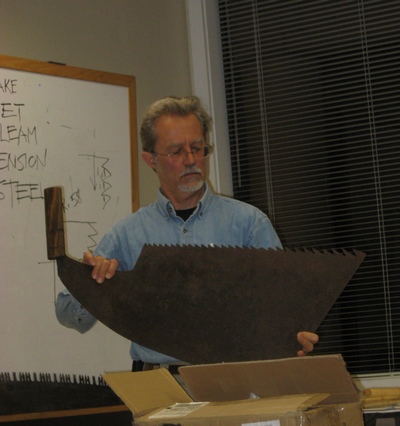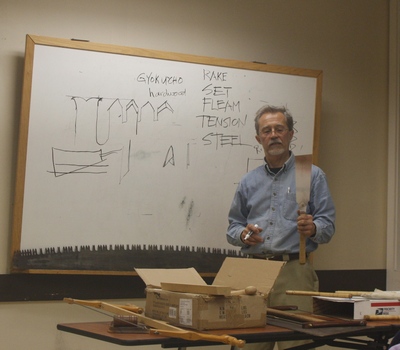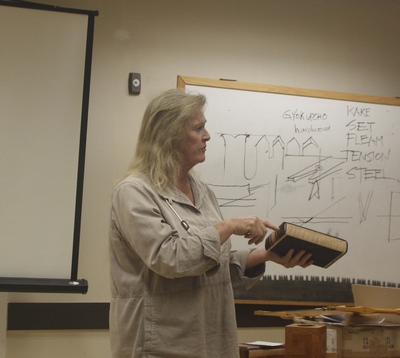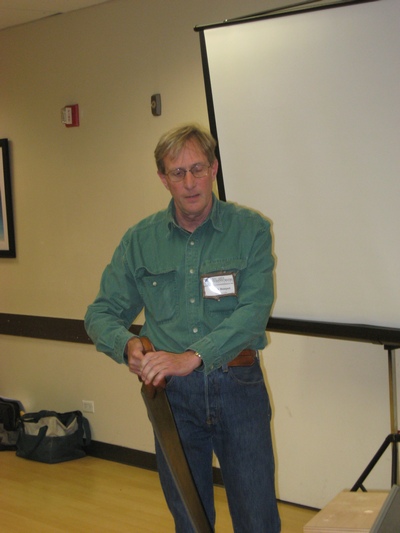Vice President's Corner
At our recent meeting (March 20th) we heard announcements of the biennial BAWA Woodworking Show chaired by Claude Godcharles. I think it is terrific that our Club takes on this effort and reaps
the enjoyment of being able to show our work to family and friends as well as strangers who visit the exhibit that
week-end. Several years ago I was able to take in five woodworking club shows in one
calender year - all interesting and all different. San Diego is the whale in the room with something like 1,800 members
and using the venue of the San Diego County Fair to exhibit and some demonstration booths. Then, because my daughter
was renting an apartment year round while a student at Humboldt State I was able to stay there and visit the Humboldt
Woodworking Society show held at a lumberyard homecenter and woodworking tool store (I believe they have discontinued their
show). That year Santa Cruz had an exhibit (a show was only open to professionals in Santa Cruz) and I took in the Sonoma
County Woodworkers show at the museum where the club actually takes charge of repainting the rooms in which their exhibit
will reside and do all the staging (as we do) and make the description cards for each piece.
Without passing judgement on the shows put on by the various clubs I visited I want to mention the impact of geography on the clubs (and thus the several shows in our area). I made contact with an
active member of the Portland (Oregon) club while taking a class at College of the Redwoods last summer. I then had occasion
to visit him in Portland when I was there for an unrelated purpose. [I believe some of my comments also apply to the club
in Phoenix, as one of their active members was also taking the class.] So Portland has one large club serving both the city
area and the suburbs (thus it seems folks working in the suburbs can commute in for meetings and such). As a result they
have approximately 300 dues paying members and offered last year (2012 probably as this was told to me in Summer 2013) an
astounding 80 classes on woodworking-related topics!! Yes they have a show but it is called the Gathering of the Guilds and
is held in a very large venue - and other
crafts are displayed besides woodworking as the other guilds represent other
crafts.
In contrast we (Bay Area geographically) have something like five active clubs. Namely: South Bay, South County, BAWA, Diablo Woodworkers, and Sonoma Woodworkers (and not too long ago a sixth
Peninsula Woodworkers) and not far away are one or two in Santa Cruz. I am not in any way suggesting any reconfiguration of the
clubs but pointing out that the total land area, waterways, freeways and traffic have pretty much set the borders and
obstructions (drive time) so that one central club would not work as in Portland, OR or Phoenix, AZ.
The Portland club may offer a dazzling array of classes each year which seems off-hand like a lot to coordinate and organize - but this high course output is possibly a result of synergy ( the
possible result of having one larger club serving a major metropolitan area - that kind of synergy). An interesting new
development in Portland is that their club has leased a shop and offers shop time to members at very low hourly rates (well
you sign up for hours in bunches and pay a bit more in dues - the result is a low hourly charge). Organizing the shop seems
like a big job also - I mean Craig at Sawdust Shop spends full time doing that!
From my perspective I am happy with the events BAWA has and the size of our
group - even if it means fewer classes offered and having to pay to use the Sawdust Shop at commercial rates. Speaking of our
classes I just finished (today) making a coffin-shaped plane under the week-end tutelage of Scott Wynn who has spoken at
our club on at least 3 occasions. The class was fun - Scott has some interesting techniques and thus I found the
experience satisfying and very proud of our club for having such experiences to offer!
At the March BAWA meeting I mentioned we had a good turnout given there was a
lecture and book signing by Peter Korn and our 'competitor' that was hosting that event was the new Museum of Craft and
Design. That new museum has not yet been open a year but is having exhibitions that are related to woodworking and design that
our members are finding stimulating so they can be excused for one small time conflict as they are good to have in
town. I don't know how or why they call that area of SF Dogpatch...yea our Club is great and glad we have what we do even if
not 300 strong.
Cheers,
Jay your VP
The meeting was called to order by Jay Perrine at 7PM by sharp raps of his gavel.
New Members and Guests:
Ted and Dorothea were visiting as guests to explain that an old member of BAWA, Paul Hamilton, had died last year and they are selling all of his tools and materials. Interested parties should call them at 650-856-1446. Great equipment.
Announcements:
Claude Godcharles, chairman of the Wood Show Committee told us the committee just completed its first meeting in preparation for the show to be held October 17-20, 2014 at Woodcraft in San Carlos. The format will be identical to the last show, 2 judges, three levels of ability and several classes or work. The fee will be $25 for two pieces, $5 for each supplemental piece and $35 for non-club members, but their fee will include membership in BAWA for the remainder of the year. Volunteers will be needed as in the previous shows and he is seeking someone to be in charge of the show setup and tear down.
The plane making workshop with Scott Wynn to be held on March 29 and 30 is full.
The BAWA meeting on April 17 will feature SF woodworker Jared Rusten who makes custom solid wood furniture. His work has been featured in the Chronicle and California Home and Design.
On Saturday April 19, Karl Helperin will host a visit to his shop in Newark.
On May 15 BAWA will present at its monthly meeting, Chris Weiss, co-founder of MRCW Design/Build. Chris was the lead carpenter on the construction of the Japanese style estate house of Larry Elision in Woodside.
On Saturday, May 24, Bill Henzel will host the Toy Workshop at his shop in San Jose.
The speaker at the March 20th meeting will be Scott Wynn who will talk about handsaws. Scott will also hold a wood plane-making workshop over the weekend of March 28-30. See the schedule for cost and sign up info. Scott plans to have attendees construct a coffin sided smoothing plane. The cost of the workshop includes all materials except for the plane blade.
On April 19th we will have a visit to the shop of our recent speaker, Carl Felperin, of Felperin Design. On April 26th we will have our Rebuilding together effort which will take place at a Day Care Center in San Mateo. We will be partnering with Equinox who will take care of the non-woodworking activities. We will be repairing a play structure, fencing, and shelves. Dan Goodman circulated a signup sheet.
On May 24th we will be having a Toy Workshop at the shop of Bill Henzel. A signup will be available at a future meeting. Frank Taylor made a plea for volunteers to do some of the prep work in their own shops in advance of the Workshop. We are promised a gourmet lunch by Bill.
Vice President Jay Perrine is organizing a one-day workshop on Furniture Design. Look for an announcement soon.
Scott Wynn on Handsaws
Architect, Woodworker, Author
or Getting it Right with Fleam,
Rake, Set and Tension

Similar to hand planes, saws are designed to perform specific cutting functions. The old panel saw so common in United States use has deteriorated in quality and been largely replaced by high end saws from Lee Valley, Lie Nielsen and many fine pull stroke saws from Japan. You can find old Disston saws in garage sales and many of the older ones are high quality tools and can be cherished as collectibles.

Scott showing old saw. Photo courtesy Frank Taylor
But which saw should I get? Scott explained that you need several saws, each for a defined purpose. There are two basic types of saws: ripsaws cutting with the grain and crosscut saws cutting perpendicular to the grain. Ripsaws typically have flat-bottomed teeth, while teeth on a crosscut saw are angled to a point.
The pattern of teeth and gullets between the teeth are designed to efficiently clear the wood chips from the cut. If the gullet gets packed, the saw will not track to the line. If the gullet is too deep, the teeth become weak and susceptible to breakage. A micro-bevel on the end of the tooth permits a deep gullet and faster cutting.
What characteristics describe the tooth arrangement of a saw?
The Rake of a tooth is the angle of the cutting edge of the tooth relative to the length of the saw blade. If the cutting edge is perpendicular, the rake is zero. If it leans back from the cutting direction, it is negative; forward is positive. Western handsaws typically have a negative rake while Japanese saws have a positive rake.
The Set of the saw teeth describe the alternative angle of the tooth to the vertical plane of the saw blade. Bending the teeth to alternating sides of the blade, improve blade clearance, reduce friction and make sawing easier. Many blades are tapered into the center, reducing blade thickness where binding might occur.
Fleam does not occur when you have a congested throat or bronchitis. Fleam describes the angle of the saw tooth tip to the horizontal plane of the saw blade. A tooth tip at 90 degrees to the blade length is usually found on ripsaws. Crosscut saws may have fleam angles from a few degrees to 45 degrees off perpendicular. Japanese saws are usually cut at 15 degrees for hardwoods to about 30 degrees for softwoods.
Tension can be something you feel when you cut off line or it can describe the rigidity or stress of the saw blade. Western saw blades increase tension by increasing the thickness of the blade. Japanese saws achieve tension by stretching the sawblade, permitting a thin blade, thin kerf and narrow blade. Stretching can be accomplished two ways: hammering the blade with a peen hammer to tune it where the tension will be built up near the teeth, or to put the blade in a frame and stretch it as in a frame saw. Japanese pull stroke handsaws are frequently tuned by peening, requiring a skilled and journeyed craftsman.
Circular saw blades found in table saws and other industrial formats frequently have laser relief cuts in the body of the blade to control tension.
Saw Steel hardness must be balanced to achieve durable sharpness without brittleness. In the 1800s, Disston became famous for its saw blades, achieving a Rockwell hardness measure of 52-54, while their competitors were in the range of 46-48. The secret was to roll the steel and control the direction of the grain of the steel relative to the teeth of the saw. The teeth were cut parallel to the grain of the steel.
Today, some Japanese saws achieve hardness rating of 58. There is a defined technique for laying the blade on an angled anvil and striking the body of the tooth just behind the tooth where it lies flat on the anvil with an indented head of a special hammer.
Specialized Types of Saws:
Timber saws cut in both directions and have alternating peg or lance teeth and raker teeth that are slightly shorter than the lance, or cutting teeth. Raker teeth scrape and clear the debris from the cut. The Japanese timber saw is a one-man saw compared to the western two man saw. The large hump back blade looks something like a large meat cleaver.
The keyhole saw are configured for a pull cutting stroke and can be rotated in small aperture holes.
Mortise saws or Azebiki saws are useful in cutting sliding dovetails and are usually used with a guide.
Dovetail saws for sliding dovetails can be made by mounting an old rip saw blade section in a block of wood, allowing the depth of the length of the blade to change by adjusting the height of the blade extending out of the handle. It is well suited to millwork, not fine cabinetry.
Veneer Saw teeth are sharpened on one side only. The curved serrated blade is held firmly against a straight edge guide.
Western and eastern frame saws share many characteristics including a 7 degree rake angle.
When questioned about his favorite saw, Scott recommends the Gyokucho. Scott brought in a wonderful collection of his saws for our perusal. Per usual, we were fascinated to learn so much about how saws work and the varieties available. Per Madsen is to be commended for his great program work

Scott discussing Japanese saws. Photo courtesy Yeung Chan

Show and Tell followed after a 10-minute break. First up, Kim Newberry, one of our newer members brought in three of her elegant boxes. In one box with rounded sides and a rotating lid, she had faced a dilemma of locating the side pins on which to rotate the box lid. Off center and the lid would not align with the box. She solved the challenge by making a MDF guide placed inside the box and drilling holes from the inside of the box to the outside. The box was made of Mexican ebony and claro walnut.

Her Kleenex box was made of 1 inch squares of lacewood, glued into panels with alternative grain direction.
Mark Bouquet mowed us down with his collection of antique panel saws, several from the late 19th and early 20th centuries. His Disston was made between 1878 and 1888. He frequents garage sales and has found that collectors gravitate towards the hand planes and neglect the saws. He has repaired several handles by finger jointing on replacement horns. Great collection and it attracted lots of attention.

John Blackmore brought in a 36 inch high display table made entirely of Western red cedar, sap wood for the legs and heartwood for the top, sides and dovetailed drawer. The sides and drawer were positioned with an open gap of 5 inches below the tabletop, just to add a sense of mystery to the piece. What’s the gap for anyway? The legs are tapered on the inside on two sides, somehow giving the illusion that they splayed out from vertical, but actually being straight.

There was no door prize or raffle as Stan was not present.
And, another informative and congenial evening came to an end. We came, we saw, we learned about FLEAM and we departed.
John Blackmore
Secretary
johnblackmore@comcast.net
